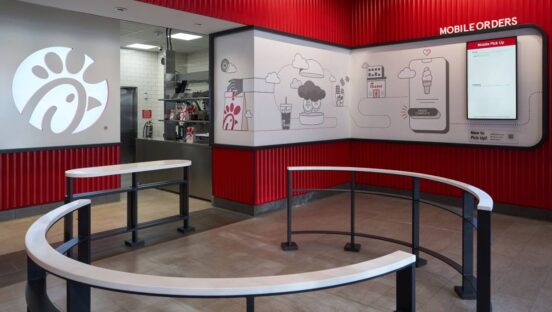In the summer of 2023, Chick-fil-A unveiled a four-lane drive-thru design with capacity to serve 75 cars at once. Naturally, it was a headline firehouse, and one that illustrated a couple of points: Firstly, digital orders had grown to more than half of the brand’s sales in some markets. And secondly, asset evolution, in general, had come a long way industry-wide toward meeting a shift in consumer preference ignited by COVID conditions.
But in that same announcement was another corner of the conversation for Chick-fil-A. The brand’s four-lane, two-story build was headed to the company’s home market of Atlanta. Meanwhile, though, Chick-fil-A was plotting a walk-up concept tailored for urban areas with heavy foot traffic. That manifestation—Chick-fil-A’s first mobile pickup restaurant—is opening March 21 in New York City.
The Chick-fil-A on 79th and 2nd in the Upper East Side will focus solely on delivery and mobile app ordering for a streamlined pickup experience.
How it works is guests order ahead for delivery or carryout via Chick-fil-A’s app or website. The restaurant is then alerted by geofencing when customers are on their way to expedite the process and ensure each meal is timed with somebody’s arrival.
Inside, there will be active status board screens designated for delivery or mobile pickup. Guests and delivery drivers can see when their orders are ready in real time.
And keeping in line with the brand’s DNA, Chick-fil-A said, even made in advance, meals will be handed to customers and couriers “with a smile so they can quickly be on their way.”





“While the restaurant will not offer a seating area or dine-in services, Chick-fil-A’s signature hospitality will be prominent in every step of this digital-focused experience,” the brand said, adding it would infuse “every touchpoint with reasons for guests to smile.”
The store’s operator, Jared Caldwell, currently serves as the leader of a nearby Chick-fil-A on Third Avenue and 88th Street. The brand said his selection was a “strategic decision … to meet the growing demand for digital ordering by offering additional ways to serve customers.”
It suggests Chick-fil-A could deploy these mobile pickup stores as complements to more traditional real estate, especially in city centers where it’s looking to alleviate and support capacity in lieu of a drive-thru. It’s not unlike how Starbucks supplements urban development with pickup units nearby cafes.
“At Chick-fil-A, we are always looking for ways to innovate and enhance the guest experience,” Nathaniel Cates, senior principal design lead for Chick-fil-A, Inc., said in a statement. “While digital concepts are becoming more prevalent, it’s important that we evolve in a uniquely Chick-fil-A way—meeting the changing needs of our customers without compromising the signature service and care they’ve grown to know and love.”
Caldwell, in particular, is a fitting first pick. He’s operated his Chick-fil-A on the Upper East Side since 2019, but boasts experience in the tech startup world. Caldwell’s Chick-fil-A career started in 2007 in West Palm Beach, Florida, where he spent his opening shift washing dishes. He worked there for about six years.
In celebration of the opening, Chick-fil-A 79th & 2nd plans to recognize 100 locals making an impact in the Upper East Side area by providing them with free Chick-fil-A entrées for a year. The store will also participate in Chick-fil-A’s Shared Table program, an initiative that helps redirect surplus food from A restaurants to local soup kitchens, shelters, food banks, and nonprofits. To date, more than 23 million meals have been served from Chick-fil-A Shared Table donations.
Chick-fil-A generated $18.814 billion in U.S. sales across 2022, as total revenue and income climbed from $4.32 billion to $6.37 billion. Notably, average-unit volumes at freestanding drive-thrus ended 2022 at $8.676 million, up from $8.142 million and $7.096 million in 2021 and 2020, respectively.
Chick-fil-A’s quickly diversifying lineup has plenty of growth whitespace to chase as well. There were nine brands in last year’s QSR 50 at $10 billion or above in U.S. total sales. After Chick-fil-A, the next smallest, footprint-wise, was Wendy’s, at 5,994 U.S. stores. Chick-fil-A had 2,837. Even closed on Sundays, the brand trails only McDonald’s and Starbucks in systemwide results despite the fact there are 13,036 more Starbucks and 10,607 more McDonald’s in America.








